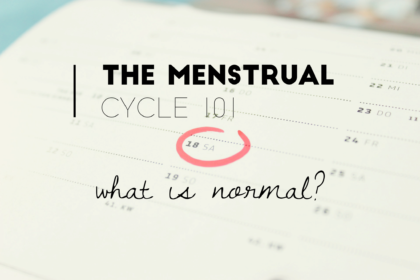The menstrual cycle is key aspect of a woman’s life. Although the cycle technically doesn’t define you as a woman, your XX genetics do that, we associate our femininity with this aspect of life. Whether you welcome it, or have disdain for it, when properly understood our ‘period’ is a report card for our health.
That being said, it is unfortunate that so many women do not understand the subtleties of their menstrual cycle. As I love educating around this in my office, I decided that it would also be a great opportunity to do it here! Over the next few weeks I will be breaking down the menstrual cycle, why we have a period, why we don’t and what it all means!
Menstrual Cycle Overview
The menstrual cycle is the primary reproductive cycle in a woman’s body. The beginning of the menstrual cycle, termed puberty, typically occurs between 10 to 12 years of age. Two to three years prior to menstruation, breast buds start to develop along with pubic and underarm hair growth. As with all aspects of the female life, diet, stress and physical exercise have a significant impact on the initiation of the first menstrual cycle (1,2). Given this, a gynecological consultation is only recommended if menstruation cycle does not occur at the age of 15 years; and/or if breast bud development, underarm and pubic hair growth does not occur by 13 years of age.
On the other end of the menstrual cycle, we have the close of a woman’s fertile years, menopause, literally meaning the end of menses. Menopause usually occurs between the ages of 50-55 years of age, and is defined as one full year without a period. This is surprising to many people, as the stereotypical menopausal symptoms portrayed in the movies are actually not menopause at all, but perimenopause. Here we see a period of irregular menstruation, hormonal fluctuations, hot flashes, night sweats, mood disturbance, changes in sex drive, skin texture and vaginal dryness. Perimenopause can last anywhere from months to years (in some cases up to 10 years!) and the severity of symptoms varies drastically from person to person(2,3). (It is also made MUCH worse by stress!)
What you need to know about the menstrual cycle?
From a big picture perspective, the menstrual cycle is simply hormonal changes that induce ovulation (egg release) and a modification of the lining of the uterus (endometrium) to prepare it for pregnancy. I say simply, but of course this is a gross simplification! The communication between the pituitary, hypothalamus and ovaries is critical, along with multiple different feedback mechanisms relating to our body fatness, stress, environment etc. This is what makes the menstrual cycle one of the most revealing system in the body!
We are born with the maximum number of eggs what we will ever have. After puberty, every month one egg is released from either the right, or left ovary this is known as ovulation. As the egg passes through the fallopian tube it can be met with a sperm, and fertilized if all of the right factors are at play. Then this ferilitized egg gets passed into the uterus via a series of tiny pulsations that happen in the fallopian tube (kind of like a conveyor belt). If implantation occurs then this whole event can culminate with a pregnancy. But in the case of the unfertilized egg, the endometrium is shed through vaginal discharge of blood and mucus and menstrual bleeding takes place (1).
Normally, the duration of menstrual cycle is 28 days. That being said, it can range from 25-32days. Anything above or below this time interval could indicate an underlying issue and should be investigated. Irregular periods are normal for the first one to two years of a young girls life, but after this time it should maintain a regular cadence.
The duration of vaginal bleeding during a normal menstruation cycle lasts for 5 to 7 days with a regular flow of blood. In the initial years, heavy flow with longer duration of bleeding is quite normal. Some women have painful and some have painless vaginal bleeding during menstruation. I like to tell my patients that when considering the menstrual cycle there is a huge difference between common and normal! It is common to have period cramps, even debilitating period cramps. But normal on the other hand includes only mild cramping that does not require the use of pain relief medication. Who knew?!
The whole menstrual cycle is divided into two main sections, the follicular phase and the luteal phase. We will be diving into the follicular phase next week, and getting into the nitty gritty of what is happening in our amazing bodies over the first 14 days of our cycle.
Until then, let me know…..
Have you ever went through a stressful period of time, and lost your period? Or got SERIOUS cramps? OR killer PMS? It has to be the worst feeling… We will be diving into why over the next few weeks!
References
- Hopkins, T. J. Johns Hopkins medicine health library. Retrieved February 3, 2017, from http://www.hopkinsmedicine.org/healthlibrary/conditions/gynecological_health/menstrual_cycle_an_overview_85,P00553/
- Staff, M. C. (2016). Women’s health menstrual cycle: What’s normal, what’s not.Mayoclinic. Retrieved from http://www.mayoclinic.org/healthy-lifestyle/womens-health/in-depth/menstrual-cycle/art-20047186
- Reed, B. G., & Carr, B. R. (2015).The normal menstrual cycle and the control of ovulation. Retrieved from https://www.ncbi.nlm.nih.gov/books/NBK279054/

